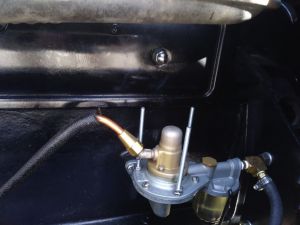- Home
- About Us
- Join/Renew
- Member Benefits
- Member Pages
- Log In
- Help
- Museum Store
I was testing the effectiveness of adding a heat shield above my 845’s fuel pump when I encountered the carburetor percolation phenomena mentioned in the 1930’s SAE reports I referenced in my vapor lock articles. I found it kind of interesting.
I had a nice hot day to test (after getting my re-cored radiator installed) and blocked the radiator flow until the water temp got up past 190 and let it run at fast idle for about 45 minutes while I measured fuel pump temps with and without heat shield (does seem to help but my setup was too crude for definitive answers).
After getting good and hot the liquid fuel disappeared from the clear filter installed ahead of the carb and fuel pressure dropped to ~zero. The engine kept running fine despite this and never stalled, but I was surprised to see liquid fuel percolating out of the inboard main jet tube like an old coffee maker, but not out of the outboard. Enough fuel was burping out that the inboard throttle plate was wet with fuel, the outboard basically dry. I screwed the inboard idle screw all the way in and the result was more fuel percolating out the inboard main jet tube and the engine kept running fine. I immediately thought there must be some problem with the carburetor main jet (despite checking this when I rebuilt it), then out of curiosity checked the carburetor bowl temperatures. Sure enough, the inboard side of the carb was running 20 degrees hotter than the outboard side, explaining why inboard was percolating and outboard wasn’t. Some more checks found that the inboard consistently runs 20 degrees warmer than outboard, undoubtedly because the outboard is facing away from the engine and subjected to less heat and more cooling.
Packard Eight/Super Eights installed a heat shield on it’s carb, but that was probably a much worse problem since the exhaust manifold was adjacent to the carb whereas it is below the carb on Pierce Eight. Heat shield might be more hurt than help on Pierce.
I think this gives an idea of how temperature sensitive the fuel system can be.
Jim

I notice the routing of the fuel line close to the exhaust manifold. On my 845 (which is original), the fuel line from the fuel pump turns upward then forward along the base of the carburetor keeping the line away from the exhaust manifold. Also, the first of the three mufflers should be underneath the fuel pump to provide some insulation from the exhaust pipe. Use alcohol free gasoline which you should be able to buy in your area.
Hi Paul,
Could you show a photo of that fuel line routing? It’s pretty difficult to route from the fuel pump to the carburetor without getting close to the exhaust manifold.
I’ve routed my fuel line from the fuel pump, over to be in front of the firewall, run vertically until above the manifolds, then close to the hood, and the cooling doors. Once forward of the carburetor, the line turns toward the carburetor, and is attached to a 90* ell on the carb bowl inlet.
My intent was to keep the line as far away from the radiant heat of the engine block and exhaust manifold as possible.
Greg Long
Greg: I’ll take a photo. It may be a couple of days before this is done.
Paul, A photo would be great, thanks. Based on your comments I suspect I have the direction of the outlet line on top of the fuel pump wrong, it should be coming outboard towards the hood rather than forward. In retrospect it was pretty dumb wondering why the line took the kick up towards the manifold, it should have been turned 90 degrees.
Greg, getting the fuel line over to run fwd along the hood ventilation doors should be ideal. The air coming out of the radiator should roll across the fuel line on its way out when the doors are open. That air is about 140 to 150 degrees, which is actually cooling when the fuel evaporation problem is generally happening with the fuel being heated in the range of 150 to 180. The exhaust manifold goes way over 600 degrees and is probably heating the fuel pump and line via direct radiation more than convection. The fuel line probably shouldn’t be insulated along that run forward as you are trying to use the 140 degree air to cool the fuel line, whereas insulation will block the cooling effect and absorb more radiation heat from the hot manifold. The insulation will absorb more radiation than the copper line.
I would avoid having the fuel line running back to the firewall. The cooling air coming out the radiator is mainly going to flow aft and down over the engine and manifolds then under the car as well as out the hood ventilation doors leaving a zone of air next to the upper firewall trapped by the hood being heated by the 200+ degree engine surfaces and much hotter exhaust manifold. That air is going to be pretty dead at low speed and idle, and perhaps turbulent but with no definite flow path out at cruising speed, meaning it will be hotter than the air in the forward engine compartment.
Jim

I have no idea why my picture above is upside down!
Jim
Let me help you!

Paul, did you have a chance to take pictures of your 845 original fuel line routing?
Thanks, Jim
Oivind, thanks for flipping the picture!
